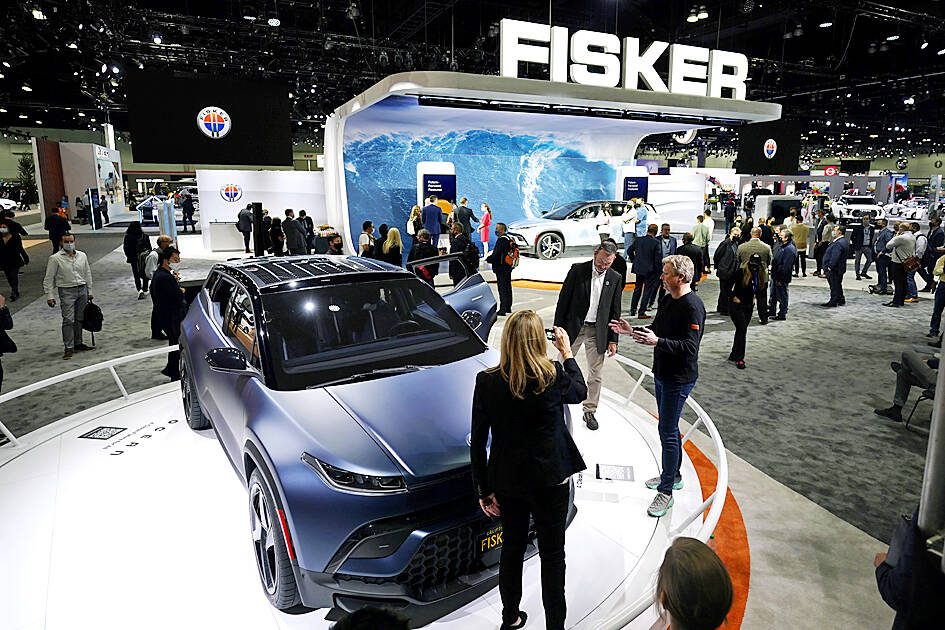Fisker Inc filed for bankruptcy on Monday, months after the electric vehicle (EV) start-up stopped production of its only model, the oft-malfunctioning Ocean sport utility vehicle (SUV).
The company listed between US$500 million and US$1 billion of assets, and between US$100 million and US$500 million of liabilities, in its petition filed in Delaware. The filing protects Fisker from creditors while it works out a plan to repay them.
Fisker is the second plug-in car company started by Henrik Fisker — a famed designer of BMW and Aston Martin sports cars — to end up in bankruptcy. An earlier venture, Fisker Automotive, filed for Chapter 11 protection in 2013 after a series of recalls spelled the downfall of its battery supplier, a fellow recipient of US Energy Department loans.

Photo: AP
The undoing of Fisker Inc was more self-inflicted. The start-up went public in 2020 as part of the wave of EV companies to benefit from the pandemic era boom in special purpose acquisition companies (SPACs). Combining with a SPAC sponsored by Apollo Global Management Inc left Fisker with roughly US$1 billion in cash and helped the company land a deal with a Magna International Inc subsidiary that manufactures vehicles for the likes of Toyota Motor Corp, BMW AG and Mercedes-Benz AG.
While Fisker Ocean SUV production started on schedule in November 2022, the first SUVs lacked basic features including cruise control. The California-based company told customers it would deploy capabilities it had promised them the following year, via over-the-air software updates.
Software bugs ended up slowing production for months, leading Fisker to repeatedly slash its forecasts. In February of this year, influential YouTuber Marques Brownlee produced a video — This is the Worst Car I’ve Ever Reviewed — that summarizes a series of issues he experienced while borrowing an Ocean from a New Jersey dealership. The video has racked up more than 5.7 million views.
Fisker produced 10,193 Oceans last year but delivered only 4,929 vehicles to customers. The company attempted a dramatic pivot in early January, seeking out partnerships with franchised dealers in North America in a move away from selling SUVs directly to consumers.
By February, Fisker warned there was substantial doubt about its ability to continue operating. The following month, the company announced it had secured US$150 million from an existing lender, though the financing was contingent on Fisker securing investment from an unidentified automaker. A week after that disclosure, Fisker said that talks with the carmaker had ended without a deal.
Magna executives said during an earnings call last month that the company’s updated outlook for this year assumed no further production of Ocean SUVs. While the company laid off 400 to 500 people from its facility in Graz, Austria, the plant employs around 7,000 workers and continues to manufacture vehicles for BMW, Mercedes, Toyota and Jaguar Land Rover Automotive PLC.
Fisker’s bankruptcy comes as EV makers struggle to adapt to slowing sales in the US and across much of Europe.
The company follows a handful of other EV start-ups into bankruptcy, including Charge Enterprises Inc, the installer of EV charging stations that filed for Chapter 11 protection in March. Other EV makers that have filed for bankruptcy include Lordstown Motors Corp, Proterra Inc and Electric Last Mile Solutions Inc.

CAUTIOUS RECOVERY: While the manufacturing sector returned to growth amid the US-China trade truce, firms remain wary as uncertainty clouds the outlook, the CIER said The local manufacturing sector returned to expansion last month, as the official purchasing managers’ index (PMI) rose 2.1 points to 51.0, driven by a temporary easing in US-China trade tensions, the Chung-Hua Institution for Economic Research (CIER, 中華經濟研究院) said yesterday. The PMI gauges the health of the manufacturing industry, with readings above 50 indicating expansion and those below 50 signaling contraction. “Firms are not as pessimistic as they were in April, but they remain far from optimistic,” CIER president Lien Hsien-ming (連賢明) said at a news conference. The full impact of US tariff decisions is unlikely to become clear until later this month

With an approval rating of just two percent, Peruvian President Dina Boluarte might be the world’s most unpopular leader, according to pollsters. Protests greeted her rise to power 29 months ago, and have marked her entire term — joined by assorted scandals, investigations, controversies and a surge in gang violence. The 63-year-old is the target of a dozen probes, including for her alleged failure to declare gifts of luxury jewels and watches, a scandal inevitably dubbed “Rolexgate.” She is also under the microscope for a two-week undeclared absence for nose surgery — which she insists was medical, not cosmetic — and is

GROWING CONCERN: Some senior Trump administration officials opposed the UAE expansion over fears that another TSMC project could jeopardize its US investment Taiwan Semiconductor Manufacturing Co (TSMC, 台積電) is evaluating building an advanced production facility in the United Arab Emirates (UAE) and has discussed the possibility with officials in US President Donald Trump’s administration, people familiar with the matter said, in a potentially major bet on the Middle East that would only come to fruition with Washington’s approval. The company has had multiple meetings in the past few months with US Special Envoy to the Middle East Steve Witkoff and officials from MGX, an influential investment vehicle overseen by the UAE president’s brother, the people said. The conversations are a continuation of talks that

Alchip Technologies Ltd (世芯), an application-specific integrated circuit (ASIC) designer specializing in artificial-intelligence (AI) chips, yesterday said that small-volume production of 3-nanometer (nm) chips for a key customer is on track to start by the end of this year, dismissing speculation about delays in producing advanced chips. As Alchip is transitioning from 7-nanometer and 5-nanometer process technology to 3 nanometers, investors and shareholders have been closely monitoring whether the company is navigating through such transition smoothly. “We are proceeding well in [building] this generation [of chips]. It appears to me that no revision will be required. We have achieved success in designing